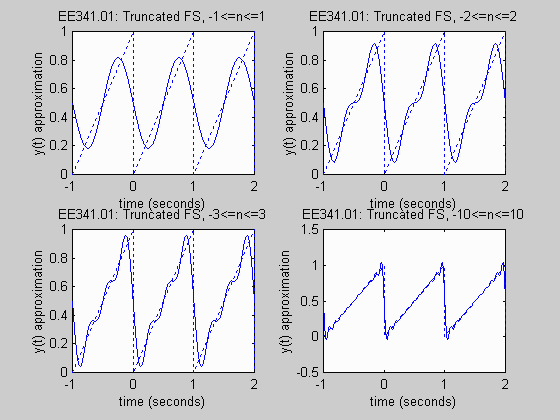
This example shows a MATLAB M-file for plotting a truncated Fourier Series. Various numbers of terms are used.
MATLAB M-File example5.m:
%
% Filename: example5.m
%
% Description: Example to show how the truncated Fourier series in
% complex exponential form approximates the real
% signal. More and more terms are taken showing a
% better and better representation of the original signal.
%
clear; % clear all variables
clf; % clear all figures
% Define parameters to plot original sawtooth
tr = [-1 0 0 1 1 2 2];
yr = [0 1 0 1 0 1 0];
% Plot Truncated Fourier Series Approximation (N = 1)
N = 1; % define number of terms to use (n = -N..N)
c0 = 0.5; % define dc bias coefficient
t = -1:0.001:2; % define time values for y(t)
y = c0 * ones(size(t)); % let initial y = c0 (dc bias) for all times
for n = -N:-1, % compute y for negative n
cn = exp(j*pi/2)/(2*pi*n);
y = y + real(cn * exp(j*n*2*pi*t));
end;
% compute y for positive n and add to y
for n = 1:N, % found using negative n
cn = exp(j*pi/2)/(2*pi*n);
y = y + real(cn * exp(j*n*2*pi*t));
end;
subplot(2,2,1); % plot approximation
plot(t,y);
hold;
plot(tr,yr,':');
hold;
xlabel('time (seconds)');
ylabel('y(t) approximation');
title('EE341.01: Truncated FS, -1<=n<=1');
% Plot Truncated Fourier Series Approximation (N = 2)
clear; % clear all variables
N = 2; % define number of terms to use (n = -N..N)
c0 = 0.5; % define dc bias coefficient
t = -1:0.001:2; % define time values for y(t)
y = c0 * ones(size(t)); % let initial y = c0 (dc bias) for all times
for n = -N:-1, % compute y for negative n
cn = exp(j*pi/2)/(2*pi*n);
y = y + real(cn * exp(j*n*2*pi*t));
end;
% compute y for positive n and add to y
for n = 1:N, % found using negative n
cn = exp(j*pi/2)/(2*pi*n);
y = y + real(cn * exp(j*n*2*pi*t));
end;
subplot(2,2,2); % plot approximation
plot(t,y);
hold;
plot(tr,yr,':');
hold;
xlabel('time (seconds)');
ylabel('y(t) approximation');
title('EE341.01: Truncated FS, -2<=n<=2');
% Plot Truncated Fourier Series Approximation (N = 3)
clear; % clear all variables
N = 3; % define number of terms to use (n = -N..N)
c0 = 0.5; % define dc bias coefficient
t = -1:0.001:2; % define time values for y(t)
y = c0 * ones(size(t)); % let initial y = c0 (dc bias) for all times
for n = -N:-1, % compute y for negative n
cn = exp(j*pi/2)/(2*pi*n);
y = y + real(cn * exp(j*n*2*pi*t));
end;
% compute y for positive n and add to y
for n = 1:N, % found using negative n
cn = exp(j*pi/2)/(2*pi*n);
y = y + real(cn * exp(j*n*2*pi*t));
end;
subplot(2,2,3); % plot approximation
plot(t,y);
hold;
plot(tr,yr,':');
hold;
xlabel('time (seconds)');
ylabel('y(t) approximation');
title('EE341.01: Truncated FS, -3<=n<=3');
% Plot Truncated Fourier Series Approximation (N = 10)
clear; % clear all variables
N = 10; % define number of terms to use (n = -N..N)
c0 = 0.5; % define dc bias coefficient
t = -1:0.001:2; % define time values for y(t)
y = c0 * ones(size(t)); % let initial y = c0 (dc bias) for all times
for n = -N:-1, % compute y for negative n
cn = exp(j*pi/2)/(2*pi*n);
y = y + real(cn * exp(j*n*2*pi*t));
end;
% compute y for positive n and add to y
for n = 1:N, % found using negative n
cn = exp(j*pi/2)/(2*pi*n);
y = y + real(cn * exp(j*n*2*pi*t));
end;
subplot(2,2,4); % plot approximation
plot(t,y);
hold;
plot(tr,yr,':');
hold;
xlabel('time (seconds)');
ylabel('y(t) approximation');
title('EE341.01: Truncated FS, -10<=n<=10');
MATLAB Plot Generated:
